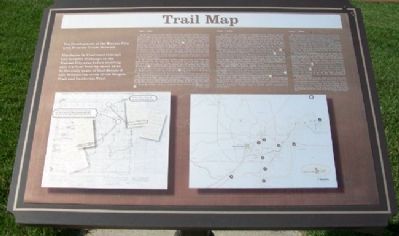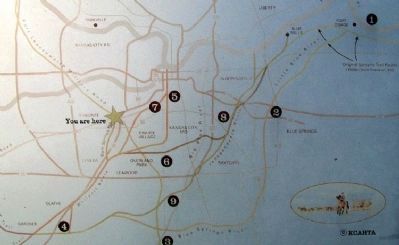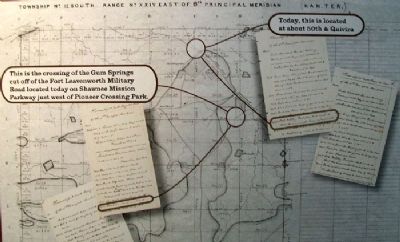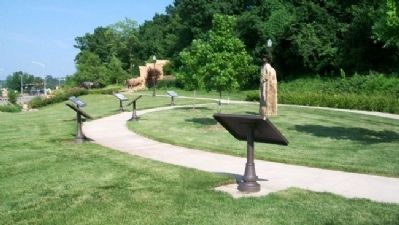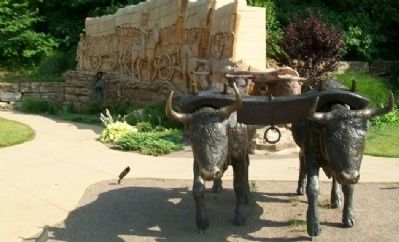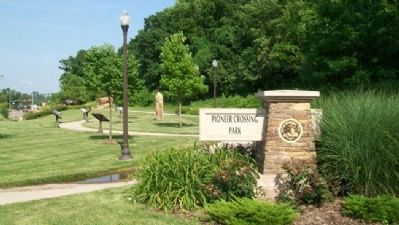Shawnee in Johnson County, Kansas — The American Midwest (Upper Plains)
The Development of the Kansas City area Frontier Trails Network
Trail Map
Inscription.
The Santa Fe Trail went through two decades of change in the Kansas City area before evolving into it's final form by about 1840. In the early years of that decade it also became the route of the Oregon Trail and California Trail.
1821 - 1827
In 1821 the young American republic found itself extended from the Atlantic to the Mississippi, with a tenuous sliver of frontier extending cautiously westward along the Missouri River from its mouth near St. Louis. Along this string of small Missouri River settlements was Franklin, precariously situated in the Missouri River flood plain across from present day Boonville in the center of the state, and on the River in western Missouri was Fort Osage (1), established in 1808 as a government "factory" post set up for Indian trade. The area we know today as Kansas City (and Independence and Westport) was in a wild and undeveloped state in 1821. Fort Osage anchored the northeast corner of present day Jackson County. The Chouteau's small fur trading post near the mouth of the Kansas river anchored the northwest corner. The Missouri river meandered unrestricted along the north boundary and the Big Blue river flooded out every spring. By virtue of the 1808 Osage Indian Treaty which allowed Fort Osage to be constructed, Jackson County was still in Osage Indian hands and would not be available for settlement until the 1825 treaty was completed.
In 1821, the year William Becknell and five companions from the Franklin area blazed the Santa Fe Trail, there were two routes for use in this area. One route proceeded south from near Fort Osage, following the ridge east of the Little Blue river, to a common rendezvous point for traders from the Franklin area called the "Blue Spring (2), in present day Grandview, crossing the Missouri border and the Big Blue river at present day 151st Street (3), and continuing to the famous Round Grove Campground in today's Johnson County, Kansas.
The other route of the Santa Fe Trail in this early era ran west from near Fort Osage, crossed the Little Blue river and turned southwest through present day Raytown. It finally turned west to cross the Big Blue river in today's Swope Park and crossed the State Line near today's 79th Street. It continued through Johnson County, KS where it met the other route near Round Grove (later, and more commonly known, as Lone Elm Campground).(4)
1828 - 1839
By 1828 with the founding of Independence the previous year, the Independence route of which we are more familiar had begun to evolve. Santa Fe traders began to bypass the "Blue Spring" route east of the Little Blue river. Instead they began to favor a route which followed the old
northerly route out of the Fort Osage area, but instead of turning west in today's Raytown to approach the Big Blue river, the traders continued on south along the "Blue Ridge," continuing southwest and meeting the old route from the Blue Spring west of present day Grandview, effectively cutting off the old route east of that point. This new route continued to cross the Big Blue river like its predecessor, near the intersection of today's 151st Street and State Line (3).
By 1834 Westport had been founded four miles south of the Missouri river, and twelve miles west of Independence near the Missouri border (5). At about the same time the landing on the Missouri river was discovered by John C. McCoy near the foot of Grand Avenue and the levee in downtown Kansas City. With the discovery of this "Westport Landing" some twelve miles upstream from the Upper Independence (Wayne City) Landing, traders who chose to unload their goods here could avoid the troublesome and sometimes dangerous crossing of the Big Blue river that bisected the county.
The route from the Westport Landing ran south through present day downtown Kansas City, meandering generally between Grand and Broadway of today, and continued into Westport. Two routes existed out of Westport, one meandering south to meet up with the route coming off the crossing of the Big Blue river in today's
Swope Park and crossed the State Line at about 79th (6), and the other route going west-southwest out of Westport continuing past the Indian missions located just west across the Missouri line (7).
By the early 1830's Independence had gained favor as the main outfitting point for Santa Fe traders, over other points to the east. But as the decade closed, and as the outfitting opportunities for commerce expanded to include outfitting for the Rocky Mountain fur trade and emigrant wagon trains destined for Oregon, Westport began to provide serious competition for Independence.
1840 - 1860
By 1840 the Santa Fe Trail had evolved into its final basic form in the Kansas City area, and by 1841 these maturing routes were sustaining traffic from Oregon and California emigrants, as well as Santa Fe traders and freighters.
The trail southwest out of Westport past the Indian missions remained essentially the same. However, the crossing of the Big Blue River in today's Swope Park fell into disuse in the 1840s. Thus the route that meandered south from Westport now crossed the Missouri line at about present day 69th street, cutting off the old State Line crossing a mile farther south.
The trail out of Independence also ran two routes. One coursed southwest out of Independence, merging with the other Independence route near today's 66th and Blue Ridge Boulevard. The other route ran south out of Independence, entering present day northeast Raytown, and continuing southwest, turning south again near today's 66th Street to follow the Blue Ridge (8). The trail continued down the Blue Ridge Boulevard corridor, meandering southwest to the crossing of the Big Blue River in today's Minor Park near Red Bridge Road (9). The trail continued southwest and crossed the Missouri line at about present day 122nd Street, thus cutting off the old Blue Ridge crossing at today's 151st Street in favor of this new "Red Bridge" crossing downstream.
In the main these were the routes as traveed after 1840, and in fact are the delineations by which these trails are most commonly considered. The great Santa Fe, Oregon, and California Trails marked these later routes as their traces until the Civil War drove the main trailheads north of the Kansas City area. With the end of the Civil War in 1865 the railroads moved the main trailheads farther and farther west.
© Craig Crease 2005
Erected 2006 by City of Shawnee.
Topics and series. This historical marker is listed in these topic lists: Exploration • Industry & Commerce • Roads & Vehicles
• Settlements & Settlers. In addition, it is included in the California Trail, the Oregon Trail, and the Santa Fe Trail series lists. A significant historical year for this entry is 1840.
Location. 39° 0.865′ N, 94° 42.41′ W. Marker is in Shawnee, Kansas, in Johnson County. Marker is on Shawnee Mission Parkway near Melrose Lane, on the right when traveling east. Marker is in Pioneer Crossing Park. Touch for map. Marker is at or near this postal address: 10401 Shawnee Mission Parkway, Shawnee KS 66203, United States of America. Touch for directions.
Other nearby markers. At least 8 other markers are within walking distance of this marker. Wagonmaster's House (here, next to this marker); Gum Springs (here, next to this marker); Fort Leavenworth Military Road (here, next to this marker); Westport - Santa Fe Trail - Oregon / California Trail (a few steps from this marker); California Road (a few steps from this marker); Shawnee Friends Mission (approx. 0.4 miles away); Quantrill's Raid on Shawneetown (approx. ¾ mile away); Campbell Home (approx. 0.8 miles away). Touch for a list and map of all markers in Shawnee.
Also see . . .
1. Pioneer Crossing Park, Shawnee KS. Kansas Travel website entry (Submitted on December 18, 2011, by William Fischer, Jr. of Scranton, Pennsylvania.)
2. National Frontier Trails Museum. National Park Service website entry (Submitted on December 18, 2011, by William Fischer, Jr. of Scranton, Pennsylvania.)
3. Santa Fe National Historic Trail. National Park Service website entry (Submitted on December 18, 2011, by William Fischer, Jr. of Scranton, Pennsylvania.)
4. Oregon National Historic Trail. National Park Service website entry (Submitted on December 18, 2011, by William Fischer, Jr. of Scranton, Pennsylvania.)
5. California National Historic Trail. National Park Service website entry (Submitted on December 18, 2011, by William Fischer, Jr. of Scranton, Pennsylvania.)
Credits. This page was last revised on October 25, 2023. It was originally submitted on December 18, 2011, by William Fischer, Jr. of Scranton, Pennsylvania. This page has been viewed 944 times since then and 33 times this year. Photos: 1, 2, 3. submitted on December 18, 2011, by William Fischer, Jr. of Scranton, Pennsylvania. 4, 5, 6. submitted on December 17, 2011, by William Fischer, Jr. of Scranton, Pennsylvania.
